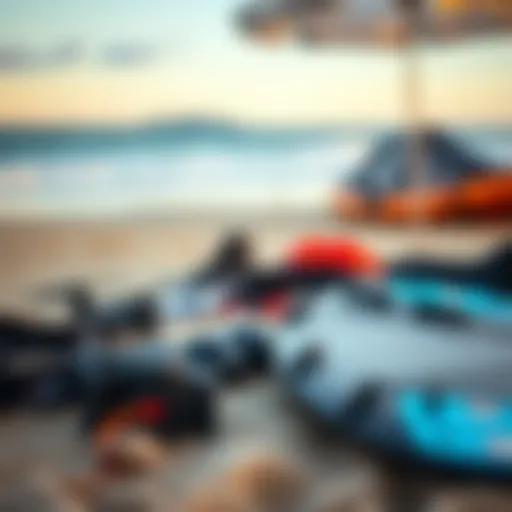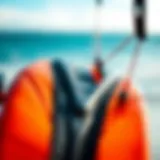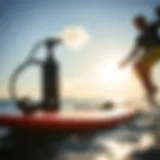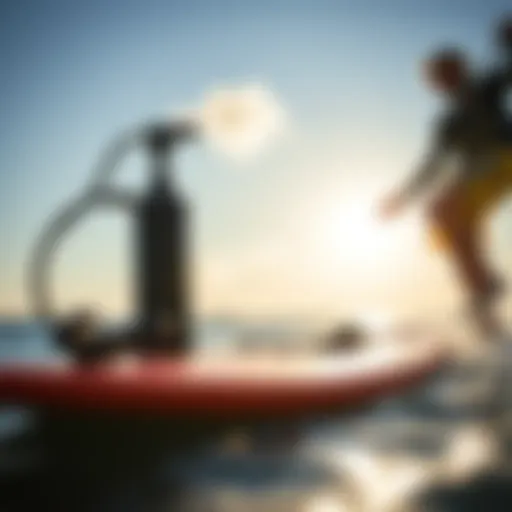Kitesurfing Kites for Sale: A Guide to Gear Selection
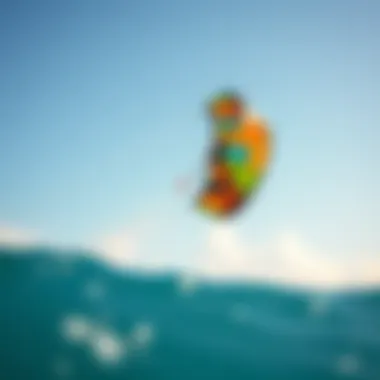
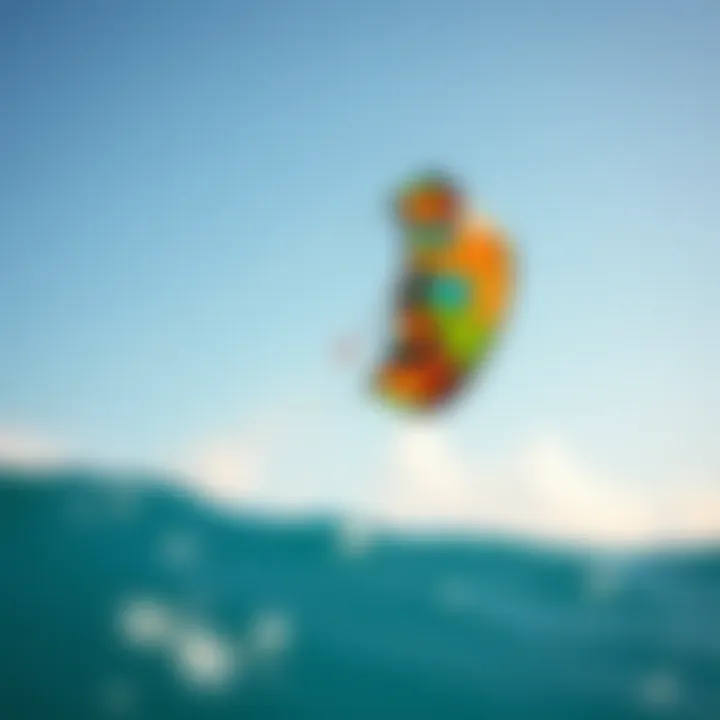
Intro
Kitesurfing stands as a thrilling blend of surfing and flying, captivating those who crave adrenaline and adventure. This sport opens up the possibility of riding waves while harnessing the power of wind. Yet, embarking on this journey requires much more than just a spirit of exploration; choosing the right kitesurfing kite can greatly impact your experience on the water. From understanding varying sizes and designs to considering brand reputations, every detail counts. In this guide, you will find essential insights aimed at making an informed purchase that will serve you well in this exhilarating hobby.
When diving into the world of kitesurfing, the options can often feel overwhelming. With numerous brands and types available, it might seem like finding a needle in a haystack. Fear not; whether you are a newcomer looking for your first kite or an expert aiming to upgrade your gear, this guide will walk you through the key considerations and options that can elevate your time spent on the water.
Gear Insights
Choosing the right gear is paramount in kitesurfing, and understanding what makes each component effective can be both exciting and daunting.
Latest Gear Reviews
The market is continuously evolving, with numerous players frequently releasing new kites. Here are some standout models that are up for grabs:
- Naish Pivot: Known for its versatility, it suits both beginners and seasoned riders. Its size ranges and punchy performance make it a favorite.
- Ozone Enduro: This is often praised for stability and speed. It’s ideal for those looking to tackle winds of various intensities.
- Cabrinha Switchblade: A kite that boasts impressive performance in various conditions. It's particularly noted among advanced riders for its incredible depower.
While these kites are popular choices, each individual may require distinct features based on their personal style and conditions they typically face.
Essential Gear for Beginners
For newcomers to kitesurfing, getting equipped with the right basics makes a world of difference. Here’s what to consider:
- Kite Size: Generally, beginner kites should be larger to catch more wind. A kite in the range of 10 to 12 meters can offer a forgiving ride.
- Control Bar: A reliable control bar is essential for handling the kite effectively. Look for adjustable lengths that can cater to your height.
- Safety Systems: Verify that the gear has robust safety mechanisms, allowing for quick release and depower as necessary.
Equipping yourself properly is the first step toward a secure and enjoyable experience on the water.
"The right gear not only eases the learning curve but can ignite an enduring passion for kitesurfing."
Please invest some time in reviewing user experiences online. Platforms like Reddit or specific kitesurfing forums can shed light on real-world usage, providing valuable perspectives that can guide your decision-making.
Techniques and Tips
Once equipped, understanding essential techniques is crucial as your kitesurfing journey unfolds.
Advanced Tricks and Techniques
As you gain confidence, you’ll likely want to step up your skills. Tricks like the jump and the backroll require practiced technique but can also be incredibly rewarding. Approaching them methodically will help in achieving a smooth landing with minimal turbulence.
- Begin with small jumps before escalating to higher ones.
- Use the waves to your advantage to gain lift during jumps.
Safety Practices for Kiteboarders
Safety should consistently remain a priority. Make it a habit to:
- Always kite with a buddy, ideally someone experienced.
- Conduct a thorough gear check before every session.
- Understand the wind conditions completely before heading out; winds can be fickle with sudden shifts.
By adopting solid techniques and an emphasis on safety, kiteboarding can transform from a hobby into a passionate endeavor that enriches both body and soul.
In summary, investing in the right gear, learning effective techniques, and following safety practices will not only enhance your kitesurfing experience but will also prepare you for future adventures. With unwavering commitment and continuous learning, kitesurfing can evolve from a mere pastime into a way of life.
Understanding Kitesurfing Kites
Kitesurfing is an exhilarating sport that combines elements of surfing and flying a kite. Knowing the ins and outs of kitesurfing kites is crucial for anyone looking to ride the waves. This section serves as a backbone for your understanding, equipping you with the essential knowledge about kites that will influence your choices and enhance your experience on the water.
The Anatomy of a Kitesurfing Kite
When we look at kitesurfing kites, it’s like peeling an onion. Each layer reveals something important that contributes to how the kite performs. Understanding these elements can make a world of difference in your kitesurfing adventure.
Types of Kites
Kitesurfing kites come in various types, each designed for different conditions and riding styles. The popular kinds include inflatable kites, which are known for their versatility and ease of use. They provide good stability and can handle a range of winds easily. On the flip side, you have foil kites that are lightweight and can cut through the air efficiently, making them great for light wind conditions.
"Choosing the right type of kite can drastically affect your performance and enjoyment on the water."
In this article, we focus on these types due to their proven track record among kitesurfers. Inflatable kites are common for beginners since they create lift effectively but may have a steeper learning curve than foil kites when it comes to flying.
Materials Used
The materials that make up kitesurfing kites significantly impact their durability and performance. Most high-quality kites use ripstop nylon, which is both lightweight and strong. This material helps the kite to resist tearing from sudden gusts of wind or rough landings. Alternatively, some models incorporate advanced materials like mylar, which can increase efficiency.
Using top-notch materials leads to kites that can withstand the rigorous demands of kitesurfing. However, these materials might come with a price point that’s on the higher side. Yet, it’s important to note that buying a durable kite can pay off in the long run, especially for regular riders.
Basic Kite Components
The fundamental components of a kitesurfing kite include the canopy, leading edge, struts, and lines. The canopy is the fabric that catches the wind, while the leading edge is where the kite’s air intake begins. Struts help maintain the shape, providing stability, and the lines attach the kite to the rider.
Understanding these elements allows you to see how they play a role in the kite's performance. A well-structured kite will deliver better lift and control. The downside? All these elements require some knowledge and attention during setup and maintenance.
How Kitesurfing Kites Function
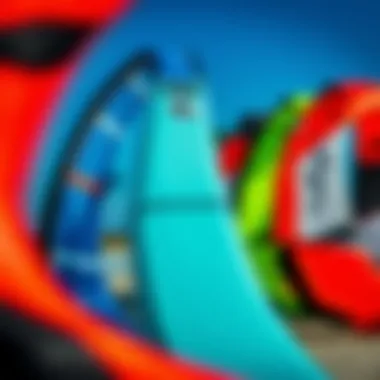
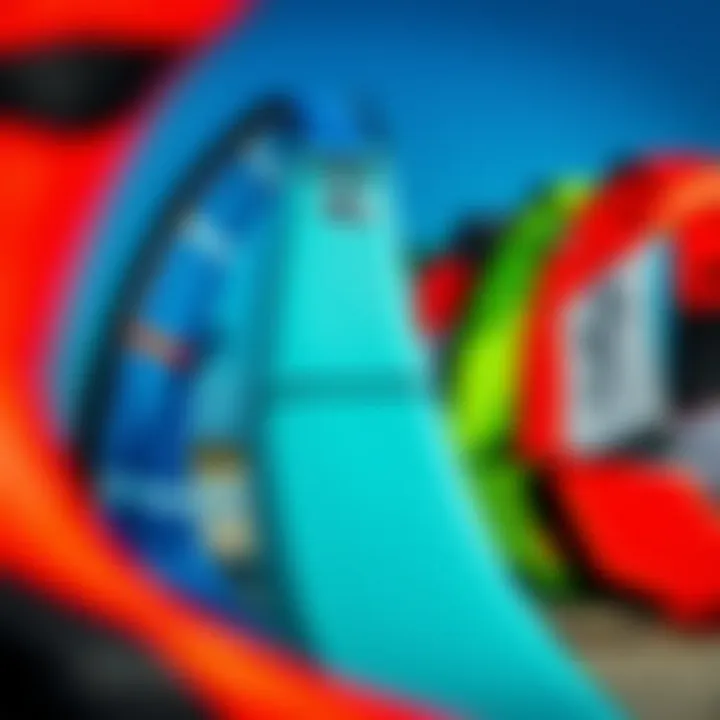
To get the most out of your kitesurfing experience, grasping how kites function is essential. The mechanics of lift, drag, and wind generation are integral to any successful ride.
Lift and Drag in Kitesurfing
Lift is the force that lifts the kite into the air, while drag is the resistance that tries to pull the kite back down. Balancing these forces is vital, as too much drag can slow you down, while the right amount of lift can provide an exhilarating ride. For example, a kite positioned correctly can harvest significant wind power, making it feel like you’re gliding through the water effortlessly.
Having a solid understanding of these forces empowers kitesurfers to fine-tune their techniques. However, too much lift can also lead to oversteering and possible crashes.
Wind Generation and Control
Wind generation revolves around the kite's ability to harness the wind efficiently. When the kite is oriented properly to the wind, it can generate more lift and enhance speed. This aspect requires an understanding of wind directions and speeds, making it crucial for your riding experience.
Controlling the kite means being responsive to changing wind conditions. It’s a skill that develops over time but is fundamental for safety and performance out on the water.
Reactivity and Stability
Reactivity refers to how responsive the kite is to the rider's inputs, while stability is about maintaining a steady flight path. Kites that are highly reactive allow for quick adjustments, which can be great for tricks and maneuvers. Meanwhile, stability is essential during gusty conditions as it prevents the kite from dragging or flipping unexpectedly.
Balancing these two characteristics is a delicate dance, as highly reactive kites may sacrifice some stability. Understanding this balance helps in choosing the right kite suited for your individual riding style.
Selecting the Right Kite for Your Needs
Choosing the right kitesurfing kite is crucial. It's not just about flying a colorful piece of fabric; it's about making sure you enjoy your time on the water, stay safe, and enhance your skills. Selecting the most suitable kite for your needs can significantly affect your performance and overall experience. The right kite can make those gusty winds feel like a sweet breeze, while a poor choice might leave you floundering on the water.
When diving into the world of kites, several key factors come into play. Understanding your skill level, factoring in your weight and size, and considering wind conditions can all steer you toward a kite that feels like an extension of yourself. Each of these elements plays a role in making sure you get the right gear, so you can navigate the waves instead of wrestling with your equipment.
Factors to Consider When Buying
Skill Level Assessment
The skill level assessment is more than just a checkmark; it’s a lens through which you can determine what kite suits your current abilities. Kitesurfing has waves of complexity, and knowing where you stand is essential. A beginner might benefit from a kite that has more stability and easier handling, while the seasoned kitesurfer can handle a kite that offers more performance and agility.
- Key Characteristic: The characteristic of the kite’s responsiveness tends to vary widely, based on where you find yourself in your kiting journey. A beginner often opts for kites that are easy to control, allowing them to focus on learning rather than getting overwhelmed.
- Unique Feature: Beginners often lean toward kites with a larger surface area, as these generate a better lift even in lighter winds. However, opting for these can come with the trade-off of reduced speed and maneuverability.
From radical turns to being able to catch the elusive wind gust, assessing your skill level shapes not only what kind of kite you purchase but also how you progress in the sport.
Weight and Size Considerations
Weight and size considerations hold a significant role in your choice of kite. Everyone has a different build; thus, your kite needs to accommodate your weight. A larger rider will generally require a bigger kite for lift, while a lighter person can harness a smaller kite.
- Key Characteristic: The sizing aspect focuses on the correlation between weight and the kite's surface area. Generally, the lighter the rider, the smaller the kite they can adequately operate in various wind conditions.
- Unique Feature: Kite size directly affects how you feel on the water as it influences speed and stability. Choosing the wrong size can lead to a frustrating experience, even for those who have the skills to handle it.
Understanding this connection helps you pick a kite that feels tailored to you, allowing you to ride comfortably and confidently, regardless of conditions.
Wind Conditions and Locations
Different wind conditions can turn a delightful day on the water into a sheer nightmare. Knowing the typical wind conditions of your chosen location is crucial to ensuring a pleasant kitesurfing experience.
- Key Characteristic: Understanding how to analyze wind patterns can dictate the size and type of kite you'll use. In areas with lighter winds, opting for a larger kite makes sense as it catches more air.
- Unique Feature: Yet, in high-wind scenarios, a smaller kite would provide better control and safety.
Performing a bit of research on local wind patterns, perhaps consulting forums such as reddit.com/r/Kitesurfing, can offer insights that position you to make better decisions about your kite setup.
Comparison of Kite Types
Twintip vs. Directional Kites
When it comes to the choice between twintip and directional kites, it boils down to personal preference and riding style. Both types have their loyal followers, but they perform differently in various conditions.
- Key Characteristic: Twintip kites are versatile and user-friendly. They allow riders to ride in either direction without having to switch their stance, which can be beneficial for beginners.
- Unique Feature: Directional kites, on the other hand, are specifically designed for wave riding and provide better performance in surf conditions. However, they require riders to have a specific stance, which might feel awkward to beginners.
The choice between these two often determines the type of kiting experience you have, as they serve unique niches in the sport.
Foil Kites Overview
Foil kites can appear quite different visually, but they come with their own set of strengths.
- Key Characteristic: They are known for excellent performance in light winds, as they are designed to stay inflated and retain an aerodynamic shape using a series of internal chambers instead of a rigid frame.
- Unique Feature: This kite type can operate efficiently in shallow waters, making them quite a popular choice for riders who frequent diverse conditions. However, they may take some time to master, especially in turbulent winds.
Understanding why someone would choose a foil kite can help you gauge whether deeper dives into the market are necessary for your kit.
Hybrid Kite Benefits
Hybrid kites combine aspects from both twintip and foil kites, offering an intriguing alternative.
- Key Characteristic: These kites balance performance in various wind conditions, enhancing versatility.
- Unique Feature: They have good floatation characteristics, making them a fine choice for those looking to dabble in multiple kitesurfing styles without investing heavily in different gear.
The hybrid design may present some trade-offs, demanding careful consideration based on your local riding conditions as well as your surfing ambitions.
"Before making a purchase, dive deep into understanding what kind of rider you are and where you’ll be riding—the right kite is out there waiting for you."
By weighing these factors as you make your choice, you can build a kitesurfing experience that fits your goals and helps you progress toward becoming a more skilled rider. Understand the elements at play, and you'll be navigating those waves with ease, no matter where they take you.
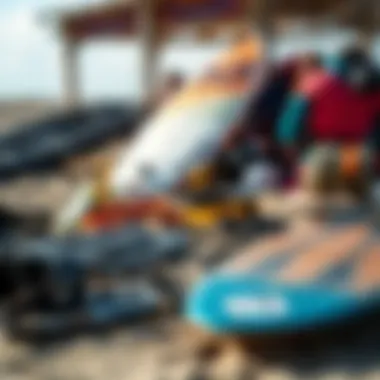
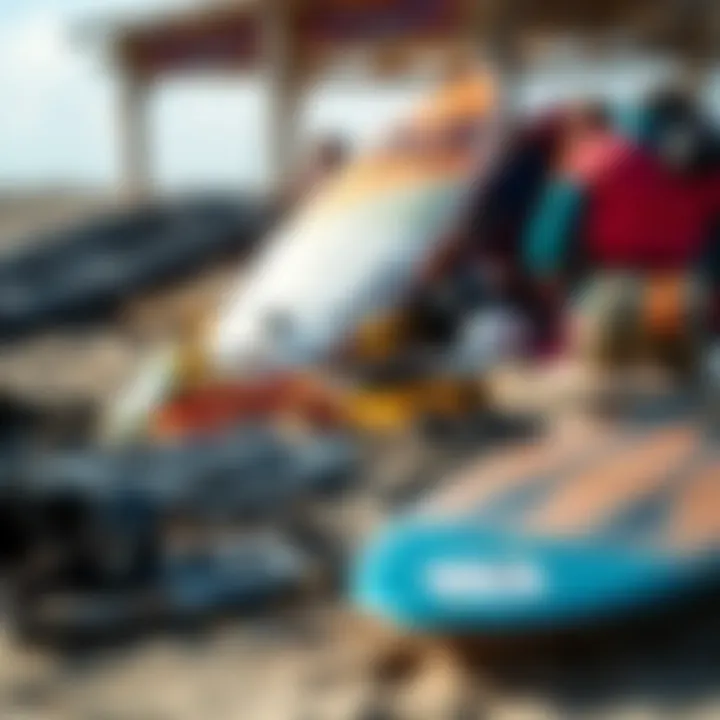
The Brands and Models Worth Noticing
When diving into the world of kitesurfing, understanding the landscape of brands and models is crucial. The variety available in the market can make your head spin, yet knowing what to look for in a brand can considerably streamline your decision-making process. Each brand carries its own identity, philosophy, and technology, directly impacting performance and your overall kitesurfing experience. From well-respected giants to promising newcomers, each brand has something unique to offer. Let's take a closer look at the prominent and emerging players in the market.
Top Brands in Kitesurfing
Naish Kites
Naish Kites has been a staple in the kitesurfing industry for decades. Known for their innovation, they provide a plethora of options for different skill levels, so there is something for everyone. What sets Naish apart is their emphasis on performance coupled with user-friendliness. A significant characteristic of Naish kites is their powerful lift capabilities.
The unique feature of Naish kites is their Adjustable Bridle System. This system allows riders to fine-tune the kite's performance based on wind conditions. One main advantage of this is that it grants the user more control over their ride. However, a beginner might find this feature slightly overwhelming at first. Overall, Naish remains a top choice for kiteboarders due to its reliability and performance.
Liquid Force
Liquid Force is another heavyweight in the kitesurfing arena. They have carved out a reputation for producing kites that excel in both freestyle and wave riding. Their kites are designed with user-friendly features, making them a popular choice among those just starting.
The standout element of Liquid Force kites is their Stability Enhancements. This features allows for smoother rides, especially in choppy waters. A benefit is that it can boost your confidence as you learn the ropes. One drawback, though, is that some models may sacrifice speed for stability, limiting performance for advanced riders. Still, Liquid Force certainly provides a solid balance for both amateurs and seasoned riders.
North Kiteboarding
North Kiteboarding is renowned for its leading-edge innovation and design excellence. Their kites are often regarded as being finely tuned for various conditions, ensuring an optimal ride regardless of your location or skill level. What makes North stand out is their focus on environmental sustainability in kite production.
The distinct feature of many North kites is their Dynamic Direct Drive, which enhances responsiveness, allowing for quick adjustments in tricky winds. This can be particularly advantageous when you're navigating through unpredictable conditions. The downside? They can be on the pricier side compared to competitors. Overall, North Kiteboarding is an appealing option for those willing to invest in a high-quality kite with a strong performance record.
Emerging Brands and Innovations
Newcomers to the Market
As the kitesurfing industry evolves, new players often bring fresh perspectives and innovations. Newcomers tend to challenge the status quo while offering affordability without sacrificing quality. Brands such as SlingShot have been making strides in delivering kites that tailor to both amateurs and pros alike. Their commitment to performance and value for money makes them a name worth following.
A typical feature of these new brands is their focus on user feedback for improving future models. The benefit here is that they often respond to real-world user needs. However, the catch is that some may lack the extensive field-testing of more established brands, leading to concerns in reliability under severe conditions.
Technological Advancements
The kitesurfing landscape is continuously changing thanks to technological advancements. This has led to kites that are lighter, more durable, and often better at harnessing wind power. Innovations such as low-stretch fabrics and adjustable designs have improved the overall performance of kites.
A major advantage of these advancements is significant performance boosts like easier handling and greater efficiency in various wind conditions. The downside is that sometimes these high-tech features come at a premium.
Sustainability Efforts
In light of increasing environmental concerns, many kitesurfing brands are delving into sustainability efforts. Brands like F-One are utilizing eco-friendly materials without compromising performance. Such efforts resonate well with environmentally conscious consumers. The critical feature of sustainability initiatives often includes recyclable materials in kite construction.
The main advantage of such approaches is the reduced impact on the environment, allowing for an ethical surfing experience. However, the challenge remains that sustainable products may initially fetch higher prices than conventional options. Overall, the trend toward sustainability is an encouraging sign for the future of kitesurfing, appealing to the growing number of eco-conscious adventurers.
Where to Purchase Kitesurfing Kites
When it comes to mastering kitesurfing, one of the pivotal steps is knowing where to snag the right kite. This section is all about guiding you to the best shopping options out there—each with its unique perks. Whether you prefer online shopping from the comfort of your home or visiting local shops for a hands-on experience, making the right choice can significantly enhance your kitesurfing adventure.
Online Retail Options
Advantages of Online Shopping
In today’s fast-paced world, online shopping has become a go-to for many enthusiasts. Convenience stands out as a major benefit; you can browse various models, read about each kite, and compare prices—all while wearing your slippers. Not to mention, options abound. Many online retailers have a wider selection than local shops. However, the missing hands-on experience can be a tradeoff. Still, it’s not uncommon to stumble upon exclusive deals or promotions that can save you a chunk of change.
Reputable Online Stores
When diving into online purchasing, being cautious is key. You want to ensure that you’re dealing with reputable online stores. Renowned names like Kiteworld, E-Column, and Extreme Kites offer assurance that you’re getting quality gear. They usually have comprehensive product descriptions, and return policies that protect your purchase. But beware, you should always check feedback from previous customers to avoid poorly rated sellers. Authentic reviews can provide insights that may steer you clear of any pitfalls.
User Reviews and Ratings
Plunging into user reviews and ratings can be a treasure trove of information. Reading about other kiteboarders’ experiences with specific models can help you gauge if a kite will suit your needs. Most e-commerce sites prominently display ratings, allowing for quick comparisons. It’s important to pay attention to both positive and negative comments. Cultivating a balanced understanding helps you avoid buyer’s remorse. There might be features that just don’t mesh with your style, so taking the time to read feedback can be time well spent.
Local Shops and Specialists
Benefits of In-Person Purchases
Though online shopping has its perks, there’s something to be said about the benefits of in-person purchases. Walking into a local shop serves as the perfect opportunity. You can touch, feel, and even try out various kites before you make a commitment. Experienced staff often work at local shops, ready to share insights and answer any questions you may have, which can dramatically shape your purchasing decision. While it may lack the convenience of online shopping, it fosters a personal connection that can be invaluable.
Finding Local Retailers
Discovering local retailers is also crucial. Many towns with a strong beach culture have shops specializing in kitesurfing gear. By doing a simple search on Google Maps or platforms like Yelp, you can easily find nearby stores. Visiting these retailers presents a chance to ask about the latest models and even join community groups or learn about local competitions. Engaging with fellow kitesurfers can provide unexpected leads on sales or discounts.
Consulting Experts
Finally, consulting experts at these local shops can elevate your purchasing experience. They can analyze your skill level, preferences, and plans for where you'll be riding. Based on their extensive knowledge, they can recommend specific kites that align with your needs. Having access to personalized guidance can save time and money. Whether you’re looking for something that can handle high winds or are after a kite for beginners, expert advice plays a critical role in the journey of kitesurfing.
Remember: Ultimately, knowing where to purchase your kitesurfing kite can streamline your entire kiting experience, allowing you to focus on what truly matters—riding the waves.
Caring for Your Kite
Caring for your kite is not just about keeping it looking good; it’s vital for ensuring its longevity and optimal performance. A well-maintained kite can significantly enhance your kitesurfing experience, allowing you to ride the waves with confidence. Neglecting proper care can result in wear and tear, giving you trouble at the least convenient moments. The importance of this section is clear: to provide you with practical advice on how to treat your gear right, so you can focus on enjoying the sport.
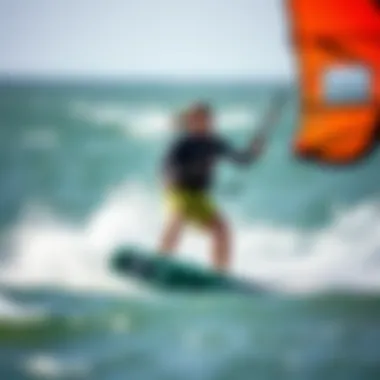

Routine Maintenance Practices
Cleaning Techniques
Cleaning your kite regularly is essential to prevent sand, salt, and dirt from damaging the fabric and its components. A simple rinse with fresh water after every session removes the debris that can cause wear. One key characteristic of good cleaning techniques is the use of gentle soaps specifically designed for kite materials. It's a popular choice because it minimizes the risk of degrading the fabric compared to regular dish soaps.
Unique to cleaning, it's important to avoid harsh chemicals that can weaken the material over time. Rinsing thoroughly ensures that no soap residue lingers, which helps to maintain the integrity of the kite. The big upside? Taking care of your kite like this keeps it performing at its best, extending its life significantly.
Storage Recommendations
Storing your kite properly when not in use is another pillar of routine maintenance. Ideally, it should be kept in a cool, dry place away from direct sunlight. This minimizes exposure to UV rays that can break down materials over time. The unique benefit of using a dedicated kite bag is that it provides protection from physical damage and keeps everything organized.
However, don’t just stuff your kite into any bag; a bag that fits well prevents the risk of crumpling the kite's structure, which could lead to issues down the line. It’s a small effort that pays off by safeguarding your investment effectively.
Inspection Guidelines
Regular inspections help you catch small issues before they turn into big problems. Look for any signs of wear, such as frays, punctures, or loose stitching. This is a crucial aspect of kite maintenance because identifying damage early can save you money on repairs later. One characteristic of effective inspection is routine checks, ideally after every session or at least every few sessions.
The beauty of an inspection is that it takes little time but can make a world of difference. By being vigilant, you can catch any potential problems and address them when they’re still manageable. Also, keeping a record of inspections can be helpful to see patterns over time and understand when parts may need extra attention.
Repairing Common Issues
When it comes to kitesurfing, wear and tear is inevitable. Knowing how to address common issues can keep you on the water rather than facing frustrating downtime.
Identifying Damage
The first step in any repair is to identify damage accurately. Look out for issues like small tears or inflation problems. Understanding the signs of damage is essential for maintaining the integrity of the kite. One of the benefits of knowing how to identify damage is that it empowers you to act rather than wait for problems to escalate.
Sometimes, the damage isn’t obvious, so getting familiar with common issues can help you detect them quicker. This characteristic of being proactive is essential for keeping your kite in top shape.
DIY Repair Techniques
Not every damage requires professional help, and that's where DIY repair techniques come in handy. Having some basic materials such as a repair tape or a patch kit can save you time and money. The advantage of DIY repairs is that they're often straightforward and quick to perform, allowing you to get back in the water faster.
One unique feature of these techniques is how versatile they can be. Whether it's patching a small tear or reattaching a handle, many common issues can be managed on your own. However, always ensure you follow guides from trusted sources to avoid doing more harm than good.
When to Seek Professional Help
Despite best efforts, some repairs may require professional assistance. If the damage is extensive, or you notice things like significant fabric degradation, it’s a good idea to consult with a specialist. Knowing when to seek professional help is key to avoid worsening the issue further. The unique benefit here is that professionals have the experience and tools needed to restore your kite properly, ensuring it meets safety standards and functions as it should.
Remember, while trying to fix things yourself can be empowering, sometimes the best option is to let someone who knows the ins and outs handle it.
"Maintaining your kite isn’t just about care; it’s about preserving your chance for thrilling rides and unforgettable memories on the water."
The Future of Kitesurfing Kites
As kitesurfing continues to grow in popularity, the technology and design behind kitesurfing kites is evolving at a rapid pace. Understanding the future of these kites helps both seasoned enthusiasts and newcomers make informed decisions when choosing gear. Not only are performance and functionality improving, but the environmental impact of kitesurfing gear is also becoming a focal point. With both aspects advancing simultaneously, the future looks promising, addressing the needs of riders while considering our planet.
Trends Influencing Kite Design
Performance Enhancements
Performance enhancements focus primarily on improving kite efficiency and responsiveness. This includes better lift-off, reduced drag, and increased stability during various riding conditions. A key characteristic of these enhancements is the aerodynamic shape of kites, which directly affects their performance in both light and strong winds.
The unique feature of many new kites is the inclusion of adjustable struts that allow users to modify the tension and structure based on wind conditions. This adaptability can significantly improve the flying experience and control, making it a popular choice for the future of kitesurfing gear. However, it’s worth considering that these advanced features can sometimes lead to higher price points, potentially putting them out of reach for budget-conscious kitesurfers.
Material Innovations
Material innovations are at the core of developing durable and lighter kites. The introduction of high-tensile fabrics and ripstop materials offers a balance of strength and weight reduction, enhancing overall kite performance. This characteristic is crucial for riders who seek both agility and resilience in their gear.
One standout feature in this new wave of materials is the use of leading-edge materials created from ultra-light yet robust composites. As a result, these kites deliver better performance without compromising durability, yet the high-performance fabrics require more specialized care and attention to prolong their lifespan in harsh environments.
Customization Options
Customization options allow kitesurfers to tailor their kites to their specific preferences and needs. Many brands now offer kites with adjustable features in terms of shape, size, and style. This adaptability is becoming increasingly important, as it ensures riders can find the perfect match for their skill level and preferred riding style.
The unique aspect of customization lies in the personalized setups that can suit different riding conditions and styles. This can improve user satisfaction and performance. However, the complexity of assembly and the learning curve involved in understanding these features can potentially discourage some less experienced kitesurfers.
Environmental Considerations
Sustainable Materials
Sustainable materials play a significant role in the future landscape of kitesurfing kites. These materials are often sourced from recycled products or produced through environmentally friendly processes. Their importance cannot be overstated, as consumers increasingly prioritize eco-conscious choices in their purchases.
A key characteristic of sustainable materials is their reduced environmental footprint. Kites made from these eco-friendly options contribute to reducing waste and pollution, making them progressively popular as awareness grows. However, the trade-off sometimes comes in the form of higher costs compared to conventional materials, which could be a consideration for many riders.
Eco-Friendly Production Practices
Eco-friendly production practices focus on minimizing waste and utilizing renewable energy sources during the manufacturing process. This is important in transforming the kitesurfing industry towards sustainability and reducing the overall carbon footprint associated with kite production. As more brands adopt these practices, they appeal to a broader audience concerned about environmental issues.
A significant characteristic of eco-friendly practices is their lifecycle management approach, which encourages manufacturers to consider the impact of their production methods. While these practices often lead to higher manufacturing costs, many consumers are willing to invest in products knowing their purchases contribute to a greater good for the environment.
Recycling Initiatives
Recycling initiatives complement the movement towards sustainability by providing ways to repurpose old or damaged kites. As the industry becomes more aware of its environmental impact, recycling programs are increasingly being established. These initiatives are vital for promoting a circular economy in kitesurfing gear, ensuring that materials are reused rather than discarded.
The key characteristic of these initiatives is the collaboration between brands and riders to facilitate the recycling process, often encouraging users to return their worn gear. Although logistics and processing can present challenges, the benefits—both environmentally and economically—make these initiatives a crucial part of the future of kitesurfing kites.

